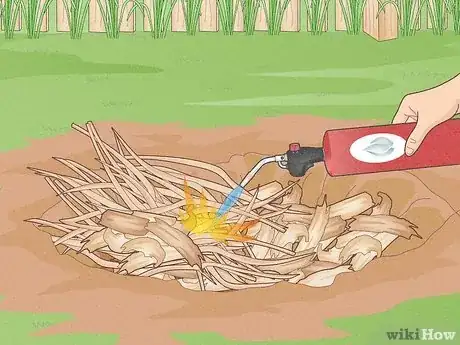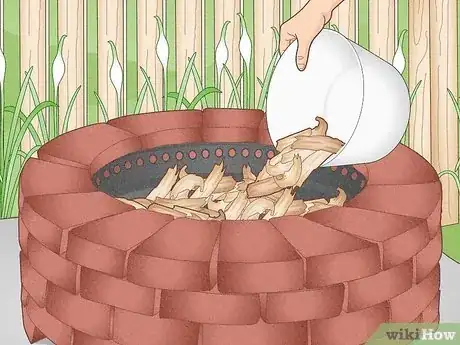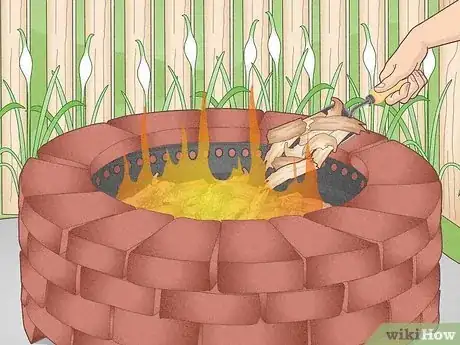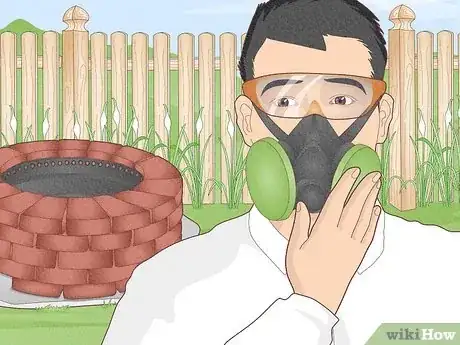This article was co-authored by wikiHow staff writer, Ali Garbacz. Our trained team of editors and researchers validate articles for accuracy and comprehensiveness.
wikiHow’s Content Management Team carefully monitors the work from our editorial staff to ensure that each article meets our high quality standards.
There are 10 references cited in this article, which can be found at the bottom of the page.
This article has been viewed 1,223 times.
Learn more...
Biochar is charcoal that is rich in carbon and made from burning natural materials, such as wood and grass. It is great for your soil and plants while also being good for the environment. The best part? You can actually make biochar in your own backyard. We’ll walk you through a few different methods to make your own small supply of biochar, and you’ll be reaping its many benefits in no time.
Things You Should Know
- Gather together biomass (grass, branches, wood, etc.) and burn them either in a stack or in a hole dug in the ground.
- Smother the burning pile with dirt or douse it with water to stop the burning once the smoke turns gray and collect the biochar in the morning.
- Carefully store biochar in sealed containers that are kept in dry, cool places and away from sunlight.
Steps
Making Biochar in the Ground
-
1Collect your biomass and load it into a hole dug in the ground. Biomass is organic material that can be used as fuel. In this case, your biomass can be dry wood, grass, straw, bracken, bamboo, or anything similar you may have lying around and cluttering up your yard.
- You can either dig a pit that’s roughly rectangular in shape, or you can dig a cone-shaped pit, which will ensure a more controlled burn.[1]
- If digging a pit to put your biomass in, the hole should be big enough to fit whatever materials you’re burning.[2]
- If digging a cone-shaped pit, the size of the pit should be around 20 in (0.5 m) in diameter and about 40 in (1 m) deep, getting narrower the deeper it goes.
- For reference, you will need about 4.4 lb (2 kg) of biomass to produce 1.1 lb (0.5 kg) of biochar.[3]
- Make sure that there is no ban in place where you live regarding burning materials.[4]
-
2Set fire to the pile by lighting it from the top. Using a lighter, torch, or even a match, start burning your pile from the very top. You may need to add some newspaper or other dry kindling to get the fire going.[5]
- Before lighting your biomass, take the proper safety precautions to protect both yourself and the surrounding area.[6]
- Wear protective gear, and have a hose on hand ready to extinguish the fire at a moment’s notice.
- Wetting the ground around your pile or trench can also prevent the fire from spreading and getting out of control.
- Do not leave the fire unattended and keep children away.
Advertisement -
3Keep adding more biomass as the old stuff burns down. Have more biomass on hand to continue adding to the pile. You want to avoid letting the pile burn down to the point where you’re getting an excessive amount of ash being produced.[7]
- Once you start to see embers or white ash start to form, start layering more biomass on top.
- You can estimate the rate at which you should be adding more biomass by the amount of smoke being produced compared to the amount of ash forming.
- A lot of smoke billowing up means that you’re adding too much too fast. If you’re seeing a lot of ash forming, then you’re not adding biomass quickly enough.
- Place the new biomass as evenly as possible over the fire and cover any gaps. This will help keep oxygen at a low level and make sure your biomass burns into charcoal, not just ash.
-
4Smother the fire with soil once the smoke turns gray. The smoke will start out white, then turn yellow, and finally a bluish gray. Once you see this gray smoke, smother the fire by covering it with a thin layer of soil. This will help keep out oxygen while still letting the embers burn.[8] [9]
- The smoke coming from the burning biomass will be white at first. This is mostly just water vapor, so nothing to worry about.
- The smoke will then turn yellow as the resins in your wood begin to burn, and it will finally turn into the thin, bluish-gray smoke that you’re waiting for.
- Instead of piling soil on top, you can also quench the fire by dousing it in water.[10]
-
5Leave your biochar to sit overnight and collect it in the morning. Letting your biochar sit will allow the decomposing process to finish, leaving you with little bits of biochar to dig up in the morning.[11]
- The biochar will look like blackened pieces of wood or whatever you decided to burn and will likely be under a pile of ash for you to dig up.
- Collect the biochar in a bucket or wheelbarrow using a shovel, since it may still be a bit hot, and let it cool before storing it or putting it to use.
Using a Fire Pit, Chiminea, or Smoker
-
1Use a fire pit, chiminea, or smoker if you can't burn biomass in a hole in your yard. Depending on where you live, burning biomass in a pit in your backyard may be against the law, so burning biochar in one of these options might be better. No matter which option is available to you, they will all yield similar results in terms of the quality of your biochar.[12]
-
2Gather your biomass. Biomass is any organic material used for fuel, so something like grass, branches, wood chips, and bark, can be used to make biochar. Using uniformly-sized pieces of wood, such as from a wood chipper, will maximize the amount of biochar produced and decrease the amount of ash.[13]
- For reference, you will need about 4.4 lb (2 kg) of biomass to produce 1.1 lb (0.5 kg) of biochar.
-
3Burn your biomass and continuously add more to the fire. Start with a small fire at the bottom of whatever burner you’re using and wait for it to begin burning down to coals before adding another layer. Repeat this process until your pile reaches the top of your burner.[14]
- Keep an eye on how much ash and smoke is forming as you burn your biomass. If too much ash is piling up, that means you need to add more burning material.
- If you’re seeing too much smoke, hold off on adding more biomass for a little bit.
- Do not leave the fire unattended at any point and keep children away.
-
4Douse the coals in water to put out the fire. Stop the burning process once your last layer of biomass has burned down to coals by soaking the hot coals in water. This is your biochar, which should look like charred pieces of wood or whatever else you burned. Once it’s cooled off enough, collect the biochar to either store or use right away.[15]
Using and Storing Biochar
-
1Use personal protective equipment (PPE) when handling biochar. This includes eye protection, long sleeves, long pants, and a respirator depending on personal health conditions as well as the amount of biochar dust that is in the air.[16]
- Biochar dust can be irritating to your eyes, skin, and respiratory system. Avoiding dumping biochar into a container or onto the soil from a high up. Also, avoid moving biochar around when it's windy.
-
2Put biochar in your garden soil to help your plants. Biochar is very absorbent and can hold lots of nutrients that will increase the soil’s fertility and help your plants thrive. You can sprinkle the biochar on top of the soil and wet it or mix it right in with the soil with a tool such as a tiller or by hand.[17]
- An essential part of using biochar is “charging” it, or loading it with key nutrients that will help the soil.
- Not charging your biochar can cause it to actually soak up the nutrients from the soil and reduce the soil’s effectiveness.
- Charge your biochar by mixing it with fertilizer, usually compost, and letting it sit for about 10 days.
- You can use a 50:50 ratio of biochar to compost, but most farmers use 20% biochar and 80% compost.
-
3Store biochar in a cool, dry place away from sunlight. Freshly produced biochar runs the risk of auto-ignition and can burst into a very hot flame when exposed to air, so store biochar in a bag and make sure it is sealed tightly.[18]
- Storing biochar in a bag prevents dust from becoming airborne in the container, which can become fuel if exposed to an ignition source.
- Never store biochar near food or beverages.
Warnings
- Make sure there is no existing fire ban in your region.[19]⧼thumbs_response⧽
- Have several buckets of water or a hose on hand as well to extinguish the fire in case it gets out of hand. Take care to soak the ground around where you will be burning your biomass to help contain the fire.⧼thumbs_response⧽
- Wear protective gear when you’re making your biochar, such as gloves, safety goggles and protective footwear, especially if you’re worried about being burned by flying sparks.⧼thumbs_response⧽
- Never leave the fire unattended, and keep children away from the area.[20]⧼thumbs_response⧽
- Never store biochar near food or beverages, and practice extreme caution when handling. Wearing personal protective equipment (PPE) is one way to minimize the risk of irritation caused by biochar to your eyes, skin, and respiratory system.[21]⧼thumbs_response⧽
References
- ↑ https://modernfarmer.com/2021/11/how-to-make-biochar/
- ↑ https://luv2garden.com/how-to-make-your-own-biochar/
- ↑ https://extension.arizona.edu/sites/extension.arizona.edu/files/pubs/az1752-2017.pdf
- ↑ https://islandschool.org/news/the-island-school/2018-4-12-how-to-make-organic-biochar-at-home/
- ↑ https://www.leafforlife.org/how/making-biochar/index.html
- ↑ https://www.allotment-garden.org/composts-fertilisers/biochar-terra-preta/how-to-make-biochar-at-home/
- ↑ https://modernfarmer.com/2021/11/how-to-make-biochar/
- ↑ https://luv2garden.com/how-to-make-your-own-biochar/
- ↑ https://www.ruralsprout.com/biochar/
- ↑ https://www.leafforlife.org/how/making-biochar/index.html
- ↑ https://islandschool.org/news/the-island-school/2018-4-12-how-to-make-organic-biochar-at-home/
- ↑ https://extension.arizona.edu/sites/extension.arizona.edu/files/pubs/az1752-2017.pdf
- ↑ https://extension.arizona.edu/sites/extension.arizona.edu/files/pubs/az1752-2017.pdf
- ↑ https://extension.arizona.edu/sites/extension.arizona.edu/files/pubs/az1752-2017.pdf
- ↑ https://dycle.org/en/blog-08-2016-enjoy-cooking-and-produce-biochar-same-time
- ↑ https://ag-safety.extension.org/wp-content/uploads/2019/05/MasterGardenerSafetySheet2012Final.pdf
- ↑ https://www.nextchar.com/biochargarden/
- ↑ https://ag-safety.extension.org/wp-content/uploads/2019/05/MasterGardenerSafetySheet2012Final.pdf
- ↑ https://islandschool.org/news/the-island-school/2018-4-12-how-to-make-organic-biochar-at-home/
- ↑ https://www.allotment-garden.org/composts-fertilisers/biochar-terra-preta/how-to-make-biochar-at-home/
- ↑ https://ag-safety.extension.org/wp-content/uploads/2019/05/MasterGardenerSafetySheet2012Final.pdf








































































wikiHow’s Content Management Team carefully monitors the work from our editorial staff to ensure that each article meets our high quality standards. This article has been viewed 1,223 times.